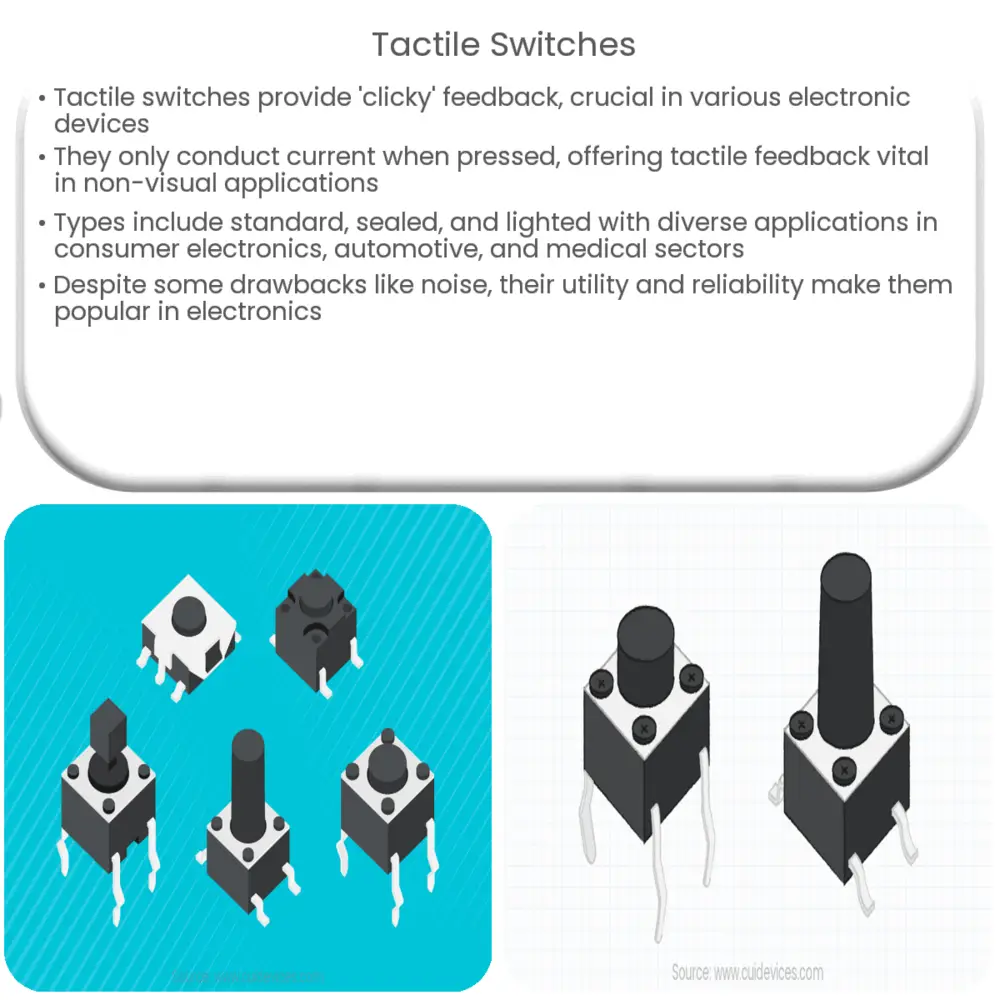Explore the world of tactile switches, their types, working principle, applications, and pros & cons in this comprehensive guide.

Introduction to Tactile Switches
Tactile switches, known for their ‘clicky’ feedback, play a crucial role in various electronic devices. These switches stand out for their distinctive ‘tactile’ response, which allows the user to feel a clear sensation when the switch is activated. In this article, we will delve into the nitty-gritty of tactile switches, their workings, and their applications.
Understanding Tactile Switches
Tactile switches, also referred to as tactile push-button switches, are a type of switch that only conducts current when you push it. A unique feature of these switches is the tactile feedback they provide, ensuring the operator is aware of the successful operation. This type of feedback is vital in many applications where visual confirmation isn’t practical or possible.
Working Principle of Tactile Switches
The essential structure of a tactile switch consists of a key top, a switch body, and a terminal. When the key top is pressed, the switch body activates a mechanism that connects the terminal, allowing the current to flow. Once the pressure is released, the switch returns to its default position, breaking the circuit.
Types of Tactile Switches
- Standard Tactile Switches: These are the most common type, generally small and offer an audible ‘click’ sound.
- Sealed Tactile Switches: These switches are designed to resist environmental factors such as dust and moisture, making them suitable for harsh conditions.
- Lighted Tactile Switches: These switches come with an integrated LED, offering both tactile and visual feedback.
Common Applications of Tactile Switches
Tactile switches are used in a wide array of electronic devices. They are particularly popular in consumer electronics, where they can often be found in television remote controls, calculators, and mobile phones. However, their applications extend beyond the realm of consumer electronics.
Industrial Applications
In the industrial context, tactile switches are employed in a variety of interfaces, control panels, and testing equipment. Their reliable operation and immediate feedback make them indispensable for many critical systems.
Automotive Applications
Tactile switches are extensively used in the automotive sector, where they form part of vehicle dashboard controls, navigation systems, and audio systems. The driver can easily identify if the switch has been activated due to the tactile feedback.
Medical Applications
In the medical field, tactile switches are found in numerous devices such as hospital beds, patient monitors, and diagnostic equipment. The clear, physical feedback of these switches is especially useful in this sector, where accurate control and responsiveness are of utmost importance.
Computing Applications
Computing is another area where tactile switches thrive. Most notably, they are used in keyboards, especially those designed for gaming or professional typing. These tactile keyboards provide a satisfying ‘click’ that can enhance accuracy and speed, particularly appreciated by gamers and touch typists.
The Science Behind Tactile Feedback
Human beings are naturally inclined to appreciate tactile feedback. When a tactile switch is activated, it provides a physical response that can be felt. This is because when the switch is pushed, it activates a tiny spring-loaded mechanism that snaps into the ‘on’ position, generating a ‘click’ feeling. This direct response triggers our sense of touch and adds certainty to our actions.
Advantages and Disadvantages
- Advantages: Tactile switches are known for their reliability, durability, and the instant feedback they provide. They are also versatile and come in many forms to suit different requirements.
- Disadvantages: On the downside, they can be a bit noisy due to the ‘click’ sound. Moreover, they may not be suitable for applications where a smooth, uninterrupted surface is preferred as the switch often protrudes from the surface.
Conclusion
In conclusion, tactile switches, with their unique feedback mechanism, have cemented their position in our day-to-day lives, being an integral part of many electronic devices we use. From consumer electronics and industrial systems to the automotive and medical sectors, the applications of tactile switches are vast and varied. Despite their few shortcomings, the utility, reliability, and tactile assurance they offer make them a preferred choice for many applications. As technology continues to evolve, we can anticipate the development of even more innovative and efficient versions of these indispensable components.

